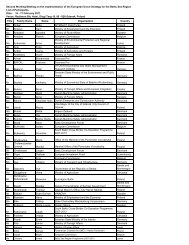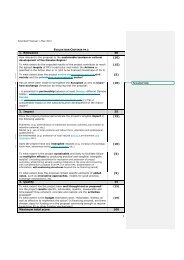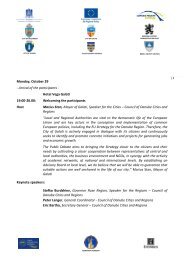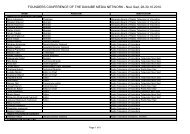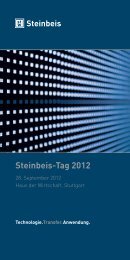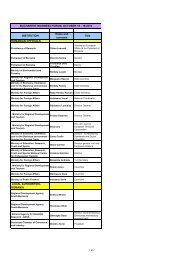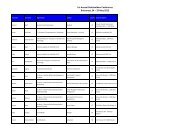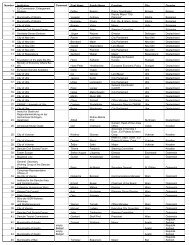You also want an ePaper? Increase the reach of your titles
YUMPU automatically turns print PDFs into web optimized ePapers that Google loves.
<strong>Project</strong> <strong>Data</strong> <strong>Sheet</strong><br />
BASIC PROJECT DATA<br />
Full project title: Development of a Next Generation European Inland Waterway Ship<br />
and Logistics System<br />
Short project title:<br />
(acronym)<br />
NEWS <strong>Project</strong> logo: –<br />
<strong>Project</strong> website: – <strong>Project</strong> ID: PA1A061<br />
Need and added value for<br />
Danube Region Strategy:<br />
At the moment, waterways as a transport mode are not used to their full potential;<br />
hence cargo transported on the Danube is only 10-20% of that transported on the<br />
Rhine (cf. DG REGIO leaflet "The EU Strategy for the Danube Region",<br />
December 2010). The NEWS project will be able to contribute to the Danube<br />
Region Strategy's (EUSDR) aim to increase cargo transport on the river by 20%<br />
by 2020 compared to the year 2010 by making container transport for inland<br />
waterways eco-friendly as well as transport-, volume- and energy-efficient.<br />
According to the EUSDR and the NAIADES Action Programme (promote inland<br />
waterway transport in Europe), NEWS will develop specific technical and<br />
logistical solutions to improve mobility and multimodality in Europe by combining<br />
a technical solution with the appropriate logistical implementation. Particular<br />
challenges such as “environmental threats” and “untapped shipping potential” will<br />
be faced by NEWS and by its adjusted container logistics concept for the<br />
targeted hinterland. Expected growth of traffic (up to 20% in the Eastern<br />
European Region until 2025, see Austrian Chamber of Commerce 2011, p. 1), is<br />
forcing an extensive and cross-border relocation of goods traffic favouring inland<br />
waterways. Road and railway have already reached their capacity limits, whereas<br />
inland waterways still offer a large potential to take over the ongoing growth of<br />
goods. One of the strategic goals of this project is to support this underutilised,<br />
but available capacity and to attract public attention to the potential of inland<br />
waterways and especially for container shipping. As a result, the full integration of<br />
waterborne transport into the EU transport and logistics chain is actively<br />
supported.<br />
The project will identify cross-border impacts, especially for the Danube Region<br />
and its hinterland, on a macro-location scale. It will include an assessment of<br />
regional added value regarding Danube linked waterways (e.g. Rhine, secondary<br />
waterways: Meuse, Saar, Mosel, Sava or Tisa) and of spatial implications (e.g.<br />
port and logistics industry, intermodality). On a micro-location scale, possible<br />
necessary new river port infra- and suprastructural elements will be identified and<br />
conceptually developed based on different case studies. Subsequently, the<br />
appropriate logistical network structures for container logistics are identified<br />
followed by a micro-analysis for the targeted catchment area. This is done with<br />
the overall goal to contribute to the development of ports in the Danube river<br />
basin into multimodal logistics centres and efficient multimodal terminals to<br />
connect inland waterways with rail and road transport by the year 2020.<br />
Taking the Austrian, Hungarian, Slovenian, Slovakian, German, Romanian and<br />
Serbian position papers for the EU Strategy for the Danube Region into account,<br />
especially<br />
• Priority Area 1 – Danube Navigation (AT/RO)<br />
• Priority Area 8 - Network of clusters, cooperation of enterprises and research<br />
and technology development (RTD) for enhanced competitiveness (AT)<br />
• Improving transport in the Danube region (HU)<br />
• Development of multimodal corridors in the Danube region (SK)<br />
• Support for economic development and competitiveness (SK)<br />
Page 1 of 6
<strong>Project</strong> <strong>Data</strong> <strong>Sheet</strong><br />
• "Transport greening" policy (SLO)<br />
• Provide modern transportation on the Danube, basis for economic growth<br />
(RO)<br />
• Provide intermodality by turning the ports into logistical centres for the intermodal<br />
transport (RO)<br />
• Shifting more goods traffic to the Danube (GER)<br />
are supported by NEWS.<br />
Objective(s) of project: • Developing and validating a novel container ship which will include the<br />
following technical innovations:<br />
o re-design of a standard inland ship hull � increase of transport<br />
efficiency (+ 100%) whilst maintaining standard technical and<br />
infrastructural dimensions<br />
o adaptable draught � crossing below even low bridges and react to<br />
altering water-levels � increase of days of navigability (+88% - 320<br />
days instead of 170 days)<br />
o an adjustable diesel-/gas-/LNG-electric energy- and propulsion system<br />
� increase of resource efficiency (+ 33%), decrease of harmful exhaust<br />
emissions<br />
• Tailoring a special-designed and integrated logistics system which will<br />
include the complying logistical innovations:<br />
o an adapted logistics and supply system for the respective demands of<br />
market in the catchment area<br />
o enlargement of the European inland waterway system for container<br />
transport � adapting the novel container ship for a use on waterways<br />
UNECE classes III and IV and making secondary waterways in Europe<br />
accessible<br />
o new river ports infrastructure concepts<br />
o re-evaluation of multimodal activities<br />
The project therefore contributes to the modernization of the European inland<br />
waterway fleet and the surrounding logistics systems. The environmental and<br />
economic performance in the European inland waterway system will hence be<br />
improved. All components (i.e. hull, propulsion system, logistics concepts) may<br />
also be used separately as innovative amendments for other purposes.<br />
Concluding, the novel container ship will be able to meet operator’s targeted<br />
costs, optimize time-management (reliability), answer to inland shipping-specific<br />
bottlenecks (e.g. low bridges, shallow waters), improve carbon footprints and<br />
thus successfully compete with road and railway transport. A significant modal<br />
shift is aspired, especially to the Danube and its hinterland.<br />
Planned project activities: The project consists of nine work packages (WP) encompassing two main fields<br />
of competence to make NEWS successful: “Ship-Building and Mechanical<br />
Engineering” combined with “Logistics Management”.<br />
The work packages follow the structure of the project, whilst each field of<br />
competence is covered by at least one WP. Additionally, there is one WP for<br />
<strong>Project</strong> Management and one for Dissemination.<br />
To a large degree, the work packages reflect the core competences of the<br />
involved partners. Overall, the work plan has been designed for exact monitoring<br />
of progress.<br />
Page 2 of 6
<strong>Project</strong> <strong>Data</strong> <strong>Sheet</strong><br />
Transboundary impact: Hinterland of the Danube, entire Danube region.<br />
<strong>Project</strong> beneficiaries /<br />
target groups:<br />
Current project phase:<br />
(please tick a box)<br />
• Small/medium-sized shipping companies and ship building companies profit<br />
from increased transport volume<br />
• Investment houses<br />
• Political institutions and organisations<br />
• Forwarders, operators, ports<br />
• Local communities<br />
• Regional authorities<br />
• Port and container terminal operators<br />
• Positive impact (emissions): shorter distances, access to new ports, costeffective<br />
waterway transports<br />
STATUS AND TIME FRAME<br />
Definition (e.g. project idea, abstract)<br />
Preparation (e.g. project proposal, feasibility study)<br />
Implementation<br />
Completion<br />
Start date: 10/2012 End date: 04/2015<br />
Notes: <strong>Project</strong> was submitted on 01.12. 2011 as FP 7 – proposal for call identifier FP7 –<br />
SST-2012-RTD-1 “Sustainable Surface Transport: Innovative fleet for efficient<br />
logistics chain”<br />
PROJECT TEAM<br />
<strong>Project</strong> leader: Vienna University of Technology / Austria<br />
x<br />
Page 3 of 6
<strong>Project</strong> <strong>Data</strong> <strong>Sheet</strong><br />
<strong>Project</strong> partner(s): • DI Ziviltechniker Anzböck / Austria<br />
Contact person:<br />
Available:<br />
(please tick a box)<br />
• Helogistics GmbH / Austria<br />
• Regional Development Agency of the West Region Romania / Romania<br />
• Lindenau Maritime Engineering and <strong>Project</strong>ing / Germany<br />
• University of Duisburg-Essen / Germany<br />
• TU Dortmund University / Germany<br />
• University of Novi Sad / Serbia<br />
• Intermodal Concepts & Management AG / Switzerland<br />
• Projektkompetenz.eu / Austria<br />
The following inland ports have agreed to act as associated partners for NEWS and will be<br />
available for implementation scenarios in WP 7, will take note of the project results, are<br />
interested to participate in the workshops and conferences organized by NEWS.<br />
• Port of Vienna<br />
• Port of Novi Sad<br />
• Port of Enns<br />
• Port of Moldova Noua<br />
The consortium’s Advisory Board will consist of the following members:<br />
• Dr. Erhard BUSEK, former Vice-Chancellor of Austria and President of the Institute<br />
for the Danube Region (IDM)<br />
• Mag. Otto SCHWETZ, President PIANC Austria, Chairman of Corridor VII (Danube)<br />
• Dr. István VALKÁR, General Director of the Danube Commission<br />
• Anton van MEGEN, Director of European United Barge Owners and Nautical<br />
Services<br />
• Dr. Andreas TOSTMANN, CEO Volkswagen Slovakia<br />
Name: Dr. Walter Mayrhofer<br />
Organisation: Technische Universität Wien<br />
Address: Theresianumgasse 27, 1040 Wien, Austria<br />
Phone: +43 676 8861609 / +43 676 88861627<br />
E-Mail: walter.mayrhofer@tuwien.ac.at / sandra.stein@tuwien.ac.at<br />
Website: www.imw.tuwien.ac.at<br />
Total budget: 2,500,000 EUR<br />
Source(s) and amount<br />
(potential sources for<br />
FINANCING<br />
Yes Partly x<br />
No<br />
National/regional<br />
funds:<br />
Page 4 of 6
<strong>Project</strong> <strong>Data</strong> <strong>Sheet</strong><br />
project ideas):<br />
(please tick a box and<br />
provide further info)<br />
EU funds:<br />
IFI loans:<br />
Private funds:<br />
Other:<br />
FP7 – SST-2012-RTD-1 Sustainable Surface Transport<br />
PROJECT ENVIRONMENT<br />
<strong>Project</strong> cross-reference: Upgrading of Inland Waterway and Sea Ports (INWAPO), CEE - <strong>Project</strong><br />
Cross-reference ID(s): PA1A060<br />
Strategic reference: As NEWS will be able to surpass existing bottlenecks such as low bridges, locks<br />
and/or altering draughts between the ports of Constanta and Rotterdam (axis<br />
Rhine/Meuse-Main-Danube), it will enable unobstructed transport links across<br />
continental Europe. By connecting the Black Sea Region to the North Sea Region<br />
and the ARA ports, an extensive Trans-European impact will be achieved regarding<br />
traversed regions as the Danube region. This objective is clearly following the TEN-<br />
T Priority <strong>Project</strong> 18. The Meuse and the Rhine constitute the entrance gates for the<br />
Belgian and Dutch inland waterway systems to this Priority <strong>Project</strong> corridor, linking<br />
the ports of Rotterdam and Antwerp, but also offering a connection towards the<br />
Seine-Northern Europe Canal, part of PP30. The Rhine-Danube corridor is one of<br />
the longest ones in the Trans-European Transport Network and crosses both, EU<br />
countries and non-Member States.<br />
Relevant legislation: –<br />
x<br />
The need for a European approach<br />
NEWS is designed to support European targets for an optimized waterborne<br />
transport. The consortium joins expertise with regard to two fundamentally<br />
important aspects: it comprises<br />
• partners and countries from the Black Sea (lower Danube) up to northern<br />
Germany and the (lower Rhine) covering a wide range of geographic and<br />
waterway-related conditions<br />
• technology providers, developers, intermediaries, incumbent operators of<br />
infrastructure, and users from five EU-countries who are jointly capable of<br />
implementing the fourfold approach of the NEWS project: technological –<br />
logistical – economic – geographic/spatial<br />
The fact that unobstructed and uninterrupted container transport on inland<br />
waterways especially for UNECE waterway classes III, IV and IV (and therefore the<br />
major part of the European waterway system) is technically not realizable up to<br />
now, clearly points out the need for a European approach. It is therefore necessary<br />
to involve several international expertises to capture all requirements. Only within<br />
the internationally composed NEWS consortium it is possible to develop, validate<br />
and implement NEWS, as otherwise technical (existing patents as basis, LNG<br />
engines for inland ships and logistical expertise would be missing. Additionally,<br />
NEWS international cooperation activities will benefit of the following activities:<br />
• Market attraction (e.g. connecting inland shipping networks and services at<br />
national and international level) and<br />
• Opportunities to access and acquire science and technology that is<br />
complementary to current European knowledge and of mutual benefit,<br />
especially regarding knowledge-transfer to East European countries (see work<br />
Programme Transport 2012).<br />
Page 5 of 6
<strong>Project</strong> <strong>Data</strong> <strong>Sheet</strong><br />
Other: –<br />
<strong>Project</strong> requirements: –<br />
Follow-up project: –<br />
OTHER RELEVANT ISSUES<br />
Page 6 of 6



